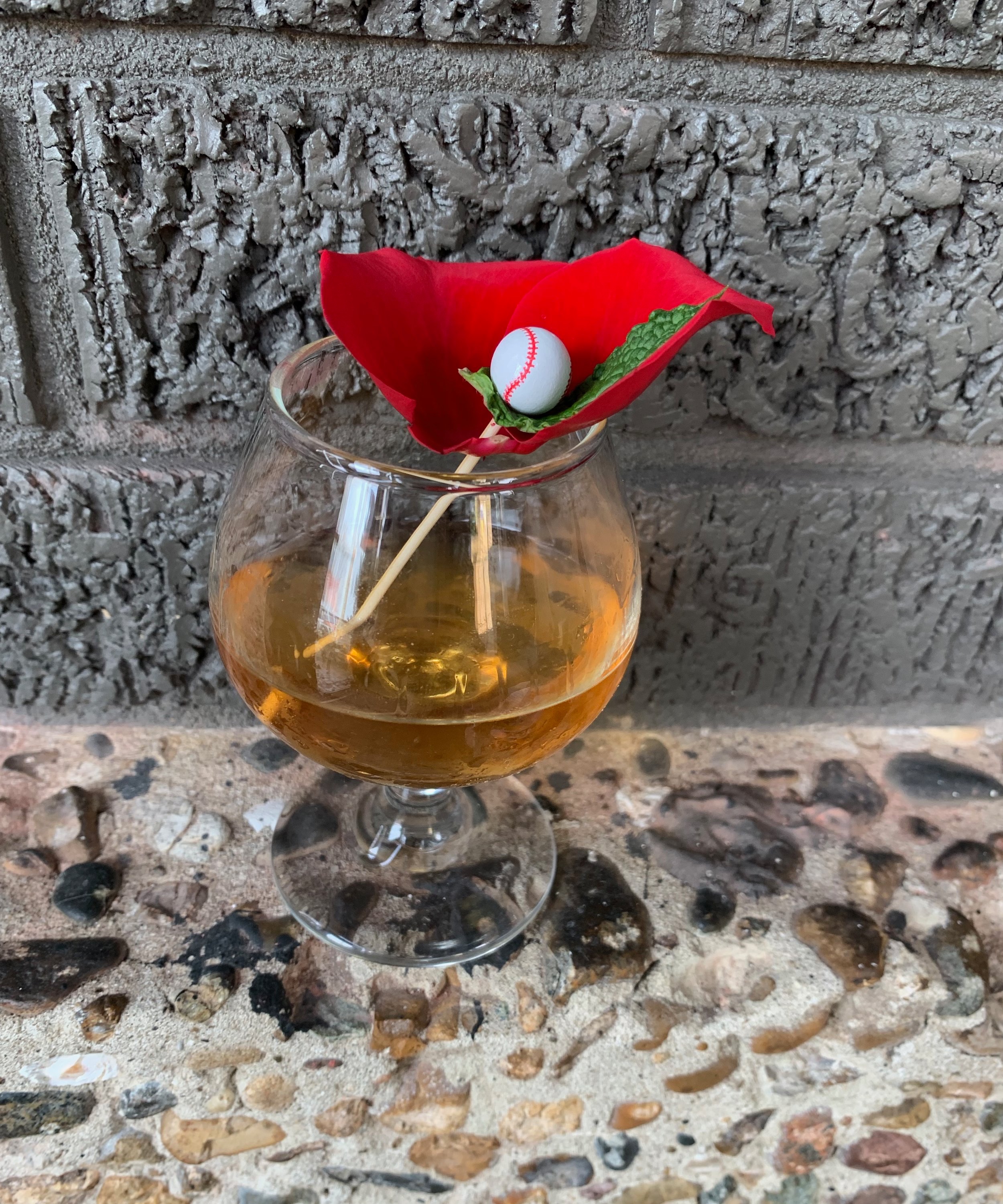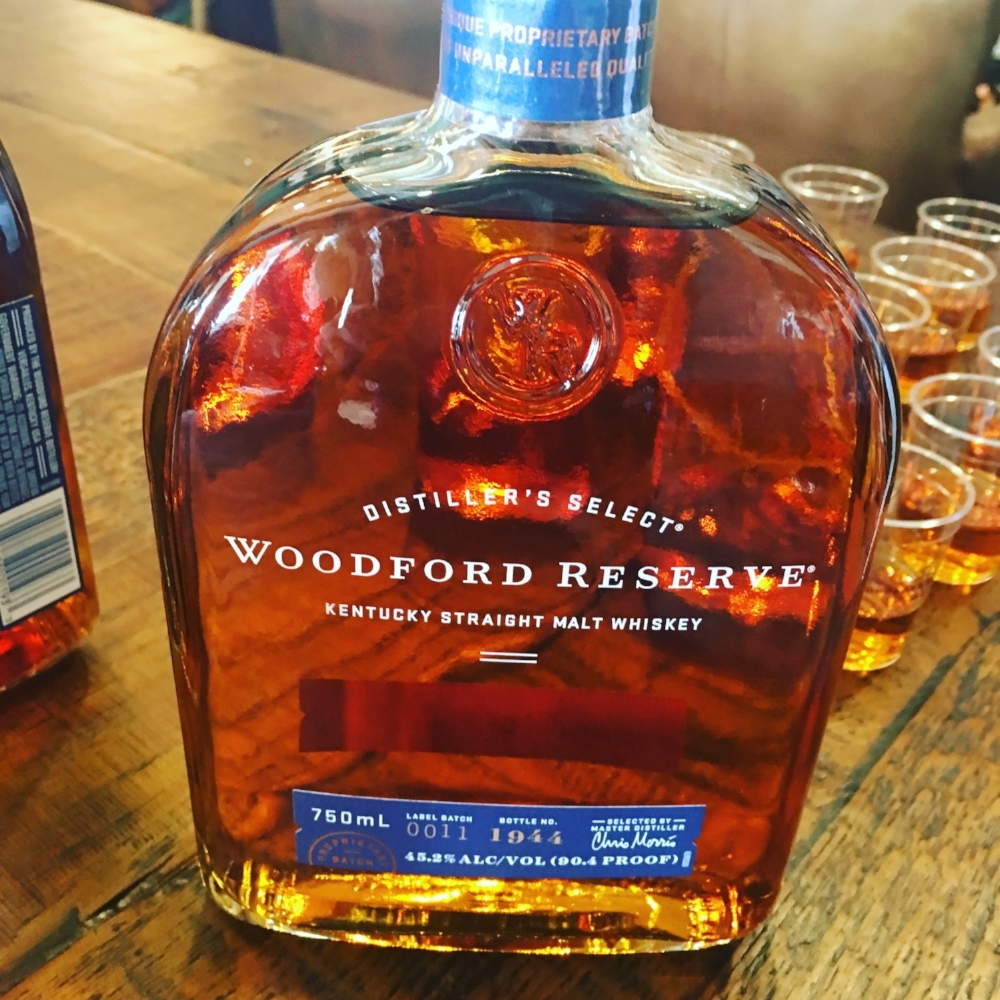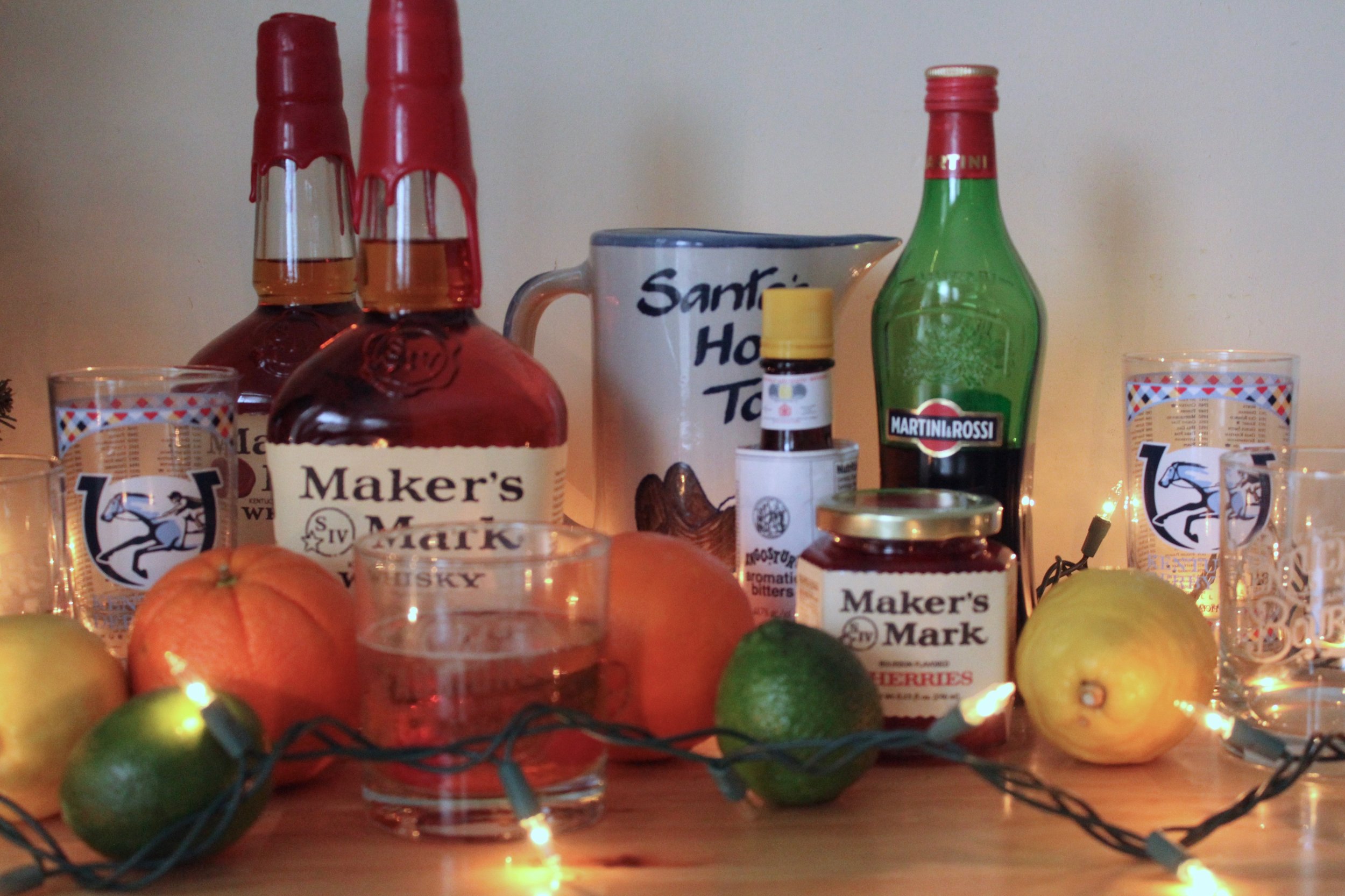BenRiach Scotch Whisky Luncheon at Ostra
Pairing Single Malt Scotch with inventive food!
The cleverly named “Peet Rose” cocktail was created by Ostra for this event.
I recently attended a lunch tasting of BenRiach Scotch Whisky at Ostra. This was an invitation I was thrilled to receive; I don’t know a ton about Scotch, and the easiest way to learn more about a spirit is to attend a tasting led by an expert. BenRiach is a 120 year-old distillery of single malt scotch; its acquisition by Louisville-Based Brown-Forman in 2016 certainly makes it more accessible to Kentucky’s whiskey lovers. Stewart Buchanan, BenRiach’s Global Brand ambassador, led us through the tasting of four BenRiach expressions, each of which was paired with a creative and delicious food course.
Stewart Buchanan, Global Brand Ambassador for BenRiach.
In walking us through the tasting, Stewart pointed out that many folks who are new to Scotch often associate the spirit with heavy notes of smoke and earth. The peat flavor is is introduced into the spirit by drying the core grain — malted barley — over peat smoke for several hours. BenRiach offers both peated and unpeated expressions, offering a lot of room for exploration of the spirit’s flavor.
Tasting notes for BenRiach Whiskys
BenRiach 10 Year:
This accompanied our starter dishes of a kale pallet, oysters, and spotted prawn ceviche. I loved the mix of a lighter whiskey with these fresh and citrusy dishes.
Proof: 86
Nose: toffee, vanilla and pear
Palate: green apple, sherry, clementine
Finish: light spice, nutmeg
Ostra’s Jay Kale salad with citrus vinaigrette and goat cheese.
BenRiach 20 year
This accompanied a main corse of Wild Boar Gemelli, truffle honey fries, and crispy brussels sprouts. Honestly, the whisky and the pasta were so amazing together that I completely overlooked my blogger duties. I loved the interplay of the gamey boar with the sweet, lightly smoky whisky. I really liked this expression a lot; the notes were more familiar for someone versed with American whiskeys.
Nose: Baked Pear
Palate: honey and red wine
Finish: lemon and barley
We finished with two peated expressions, Benriach Curiositas 10 Year and BenRiach Authenticas 25 year. These were served with two amazing desserts: the cricket flour brownies and the red velvet churros with cayenne nutella dipping sauce. While I’ve never been one for peated whiskys, this pairing really worked well to coax out the notes of the spirit. I don’t fully trust my palate enough to give tasting notes on the peated whiskys; I simply haven't worked with them enough to get a great read on what I’m tasting and smelling. The Authenticas 25 year opened up to a lovely raisin palate, which worked well to cut the indulgent chocolate notes of the dessert. (And that churro was nothing short of lfie-altering!!)
Thanks so much to Brown-Forman, BenRiach, Lemonade PR, and Ostra for the invitation. I look forward to further pursuing my nose for Scotch!
Angel's Envy Oloroso Sherry Cask Finish Bourbon Review
Tasting notes on a very limited edition bourbon expression.
Last week, I attended a media preview and tasting of the latest release from Angel’s Envy: Oloroso Sherry Cask Finish Bourbon. Angel’s Envy is one of those small, family-owned whiskey labels that has a cult following — fans love the unique bourbon and rye whiskeys finished respectively in port wine or rum barrels to provide a gently altered flavor profile. The limited release Oloroso Sherry Cask Finish was a pretty big deal to bourbon geeks: it was the first new Angel’s Envy expression produced since 2013, and the first to be produced without the guidance of famed patriarch and Master Distiller Lincoln Henderson.
A mural at the entry of Angel’s Envy pays tribute to legendary distiller Lincoln Henderson
Lincoln Henderson was the Master Distiller for Brown-Forman for 40 years; he created the Woodford Reserve and Gentleman Jack expressions while at B-F. Lincoln retired in 2004, but by 2006 his son Wes persuaded him to come out of retirement work on a new, family-owned distillery project. The result was Angel’s Envy, a name paying humorous homage to the fabled “angels’ share”, the portion of the whiskey that evaporates in the warehouse each year. Mr. Henderson passed away in 2013 at the age of 75; Wes Henderson and his sons Kyle and Andrew continue to run the family business with an eye toward their patriarch’s vision.
Henderson Family Tree
Wes and Kyle Henderson sample new make.
After a quick tour of the distillery, Wes and sons Andrew and Kyle treated our media group to the first “outsiders’” taste of the new, limited edition bourbon expression, Angel’s Envy Oloroso Sherry Cask Finish.
Tasting Notes:
Proof: 100
Nose: Raisin and New Oak
Taste: Sherry, Raisin, and Hazelnut with a secondary toffee note.
Finish: Oak and Floral
This is a really unique expression. I LOVED the nose on this. It was this gorgeous raisin and oak scent that felt like a storybook holiday. The sherry definitely came through on the initial taste; we were told that Oloroso is a drier sherry, specifically chosen to keep the whiskey balanced and not overly sweet. I could see this making a really sophisticated and subtle Manhattan.
This is a very limited run of 3,600 bottles at $199 each. The whiskey will be available at the Angel’s Envy Distillery Store in downtown Louisville and distributed to a handful of Louisville area liquor stores. Public sales will begin on February 15th at 8 am; you can add your name to the VIP Access list by joining the Angel’s Envy 500 Main Club.
After the tasting and lunch, we were treated to a cocktail class with Finishing Room Bar manager Mike Bohn. Mike was so knowledgeable about the history of cocktails and the best ways to coax flavors out of the whiskey. You can sign up here for your own cocktail class.
Thanks so much to Angel’s Envy for the opportunity to sample this new expression!
Woodford Reserve Kentucky Straight Malt Whiskey
A tasting event for Woodford Reserve’s latest whiskey expression.
During Derby week, I had the amazing opportunity to visit the Brown-Forman suite at Churchill Downs for a day of bourbon and horse racing. Seriously, who could turn down that combo?
The Woodford Reserve Suite at Churchill Downs. Shop the Draper James Throw here.
The tasting event was held on the Wednesday before Derby, a day which I hope never gains a nickname as "cute" as Thurby, and which still retains the charm of a locals' day at the track. As Woodford Reserve Master Distiller Chris Morris and Assistant Master Distiller Elizabeth McCall poured cups for tasting, we learned that a group of bourbon media professionals had been assembled for the first tasting of Woodford's new Kentucky Straight Malt Whiskey, a product which will be available for purchase in some markets as early as next month.
If you ever have the chance to attend a Woodford Reserve whiskey tasting, you owe it to yourself to participate. The Woodford team puts so much care into the details -- whether they're doing the signature flavor wheel food pairing exercise or a comparative whiskey tasting, as we experienced on this occasion. Mr. Morris took care to explain that all four expressions in the brand's whiskey portfolio -- Woodford Reserve Bourbon, Woodford Reserve Double Oaked, Woodford Reserve Rye, and Woodford Reserve Malt -- were comprised of the same three grains: corn, rye, and malted barley and are bottled at 90.4 proof. Of course, the percentage of grains in the individual mash bills as well as the special finishing process in the case of Double Oaked are what produce such distinct flavors in the different distillates.
We started with the original WR expression, the bourbon as a baseline spirit for tasting. We followed with my favorite expression in Woodford's portfolio, Double Oaked. The Double Oaked is traditional Woodford juice that, upon maturation has been finished in a second charred oak barrel. This produces more of the sweet caramel notes for which the brand is famous. I love this one as a sipping whiskey or as an after-dinner "dessert" drink, as it has prominent brown sugar notes; it's sweet without ever becoming cloying.
Next on the tasting menu was Woodford Reserve Rye. This one is Bob's go-to cocktail whiskey; it makes a fine Manhattan, sour, or Old-Fashioned. It's peppery and earthy, but doesn't enter into the high-rye herbaceous "bite" that so many ryes often display. We consider it the "house whiskey" of HerKentucky Headquarters; I love the idea that this rye whiskey is made from Brown-Forman's pre-Prohibition recipe.
Elizabeth McCall leads a tasting of Woodford Reserve whiskeys
Then it was time for a sip of the new malt product. This one was fascinating, y'all. It had a lot of the characteristics of traditional Woodford bourbon, but was somehow lighter. The nose was strong with notes of cherry and almond. The mouthfeel was quite different from any of the other whiskeys we tasted that day; I felt a strong evaporation on the front of my tongue, somewhere between the sweet and salty tasting zones. I think that the Straight Malt expression will make a really interesting whiskey for mixologists; it will create some unique cocktails!
Mr. Morris made the very important distinction that this whiskey is not to be considered in the class of single malt Scotch whiskeys, but rather it is an experimental expression of American whiskey. Elizabeth led us through the tasting notes, as you can see in the video below.
Elizabeth and I also had a chance to chat about some of our favorite Draper James pieces. She was featured on the brand's Love, Reese blog as part of the Real Women, Real Clothes series, and partnered with Draper James on her Derby Week looks. How perfect is that partnership? We posed for a #draperjamesgirl photo as the event wrapped up.
Draper James Girls at the track. Shop Elizabeth's dress and my dress. (My fascinator is c/o Off Broadway Shoes and my necklace is from Elva Fields.)
Thanks so much to Woodford Reserve for an amazingly relaxing and educational Derby Week event! Cheers, y'all!
10 Terms that Bourbon Beginners Need to Know
How to talk about bourbon like an insider
Bourbon is everywhere these days, y'all. In 20 years, it's gone from the drink you enjoy at Kentucky's racetracks to the quintessential American spirit. Of course, here in Kentucky, we're at the heart of the bourbon boom, which is wonderful for everything from the tourism revenue to the resultant Kentucky culinary renaissance. But, I've noticed a little secret that we don't always want to admit: Not every Kentuckian is a bourbon expert. I've decided to start a series of HerKentucky blog and social media posts to help you decode the secret language of bourbon. Today, we'll start with a little bourbon dictionary. Here's the lowdown on ten whiskey terms that will have you talking like a bourbon insider in no time!
What are you drinking: Whiskey, bourbon, or rye?
Bourbon's mash bill is 51% corn. Jeptha Creed uses an heirloom varietal, Bloody Butcher Corn.
Whiskey: Whiskey is a distilled spirit made from fermented grain mash. These grains are, most often, wheat, barley, corn, or rye. The grain recipe (mash bill) that is used to produce the whiskey is responsible for much of the beverage's taste. Whiskey types (Scotch, Irish, Bourbon, etc.) are often determined by the spirit's country of origin. An alternate spelling is "whisky"; this is the traditionally accepted spelling in Scotland and many other countries.
Bourbon Whiskey: Bourbon Whiskey is a type of whiskey made in the United States. By law, bourbon must be produced in the United States, comprised of at least 51% corn, aged in new, charred oak containers, distilled to no more than 160 proof (80% alcohol by volume), entered into the barrel for aging at no more than 125 proof (62.5% alcohol by volume), and bottled at 80 proof or above. While we all know that the best bourbon comes from Kentucky, federal law does not mandate that the spirit be produced in our Commonwealth. For an excellent history of the legislation surrounding bourbon, see Fred Minnick's Bourbon: The Rise, Fall, and Rebirth of an American Whiskey.
Rye Whiskey: American Rye Whiskey is a distillate that must include at least 51% rye in its mash bill. (Canadian rye whiskey is a different spirit.) Historically, rye whiskey was produced near Pennsylvania; Pittsburgh was historically considered the major metropolitan hub for rye. Rye wasn't a spirit considered native to Kentucky for centuries, as our climate isn't conducive to growing that grain. Many major bourbon distilleries have recently introduced rye to their whiskey offerings. Rye whiskeys are often characterized as more herbaceous and less sweet than bourbons. I recommend Manhattan cocktails made with Michter's Rye or Woodford Reserve Rye as an entry point for rye whiskey.
How is it made?
Fermentation Tank at Woodford Reserve.
Mash bill: A mash bill is the mix of grains combined to make a whiskey. The grains are cooked and fermented. Three grains are typically found in a bourbon mash bill: corn, wheat or rye, and malted barley. The individual mash bills, or recipes, determine most of a whiskey's flavor. A wheat mash bill, like that of Maker's Mark or Pappy Van Winkle, results in a sweet bourbon. A high rye formula, like that of Bulleit or Basil Hayden's, is often described as spicy.
Sour Mash: The sour mash process of whiskey-making involves using a little spent mash from the previous batch to start the fermentation of the next batch. This process controls the growth of harmful bacteria and regulates the whiskey's pH. This process is used to make almost all bourbon whiskey.
How is it Bottled?
The Bottling Line at Maker's Mark
Straight Whiskey: Take a look at your bourbon label sometime, and you'll likely see the term "Kentucky Straight Bourbon Whiskey." This means that, of course, it is produced in Kentucky (the label, by law, must contain the state of distillation) and that it adheres to the regulations for bourbon, as defined above. Straight whiskey has been aged for at least two years; if it is aged for less than 4, the age statement must, by law, be noted on the label. Straight whiskey may be created by blending bourbons that were aged in different batches and even different years to create a consistent product. No additional additives (color, flavor, clear spirits) other than water (which tempers the proof) may be added to straight whiskey.
Bottled-in-Bond: Bottled-in-Bond bourbon was made at a single distillery, by one distiller in one distillation season, aged for at least four years in a federally bonded and supervised warehouse, and bottled at 100 proof. The Bottled in Bond Act of 1897 is considered a revolution in bourbon-making, as it ensured both quality for the consumer and standardization of the federal taxes levied on the distillers. Bottled-in-Bond whiskeys are far less common than they once were; you may see this distinction on some bourbons like Old Fitzgerald and Old Bardstown.
Single Barrel: Single bourbons are, as the name suggests, a limited release in which every bottle comes from one barrel. Due to the variations and scarcity, these are often an ultra-premium expression. Blanton's is the first bourbon that was widely marketed as a single barrel.
Small Batch: Small batch bourbons are made from a highly limited number of barrels per batch. Maker's Mark and Willett are considered small-batch bourbons.
These terms should have you talking bourbon like a pro! (Or at least an experienced amateur!) Let me know in the comments if there are bourbon basics topics that you'd like to see posts about!
How to Build a Maker's Mark Bourbon Bar for the Holidays!
Maker's Mark Distillery at Christmas
I always think of Maker's Mark as the bourbon of Christmas. Sure, there may be bourbons you drink at Derby time, and bourbons you drink on, say, your birthday. But, Maker's is the bourbon you buy for Christmas.
It may have something to do with the fabulous way that the folks at Maker's market the holiday, from nostalgic print ads to witty Ambassador gifts. It may be that Maker's Mark is the bourbon my family has always used in the bourbon balls that we make at Christmastime. Whatever it is, Maker's slays the Christmas game.
My cousin Amy had the most creative use for her Maker's Ambassador earmuffs! Lola the Chihuahua models them for us!
Since Maker's is the flavor of Christmas, it's a great idea to set up a Maker's Mark bourbon bar over the next few days. Only a few simple ingredients will allow you to offer your guests a variety of popular cocktails.
What you'll need:
- A couple of bottles of Maker's Mark
- A bottle of vermouth
- A bottle of Angostura bitters
- Simple Syrup
- Sour Mix (3 cups simple syrup to one cup lemon and lime juice)
- Maker's Mark cherries
- Lemons, limes, and oranges for garnish
If you have these items, you can mix up a whisky sour, an old-fashioned, or a Manhattan, in addition to serving your bourbon neat or on the rocks. Add a couple of sizes of glasses to allow your guests some choice.
Set everything out in an accessible place, keep fresh ice handy, and your guests will be refreshed and full of holiday cheer!
What's your favorite holiday cocktail?
National Bourbon Day!
June 14th celebrates Kentucky's native spirit! Cheers to good Kentucky bourbon!
Happy National Bourbon Day, y'all!
Of course, I joke that every day here in Kentucky is a Bourbon Day. If you're writing a book about bourbon, like I currently am, you certainly think about brown spirits every day, even if you imbibe them far less frequently.
It really is a fascinating time to be a Kentucky bourbon lover. There are 1.5 barrels of bourbon for every Kentuckian, and the bourbon industry is an 8.5 billion dollar industry here in the Commonwealth. There are bourbon-themed menus, festivals, and cocktails for nearly every taste! (P.S.: Check out the Bourbon & Beyond Lineup! I'm beyond excited to attend!)
The truth is, with all the amazing distillery tours and new releases and cocktail bars, it's also sometimes an overwhelming time to be a Kentucky bourbon lover. Are the big-name, big-price tag pours worth it? Should you save special bottles for your collection? Should you mix a cocktail, add a splash of water, or drink it straight? I have to say that, in the past several years of writing about bourbon, I've heard that question asked a million different ways. And, the real experts -- those who've spent their careers blending the perfect whiskeys -- always come around to a very similar response. In fact, I've heard a variant of these very words from Jim Beam Master Distiller Fred Noe and Woodford Reserve Master Taster Elizabeth McCall. Here you go, folks. the secret to drinking bourbon, courtesy of HerKentucky.com.
Drink your bourbon however you like it.
Let me know in the comments: What bourbon are you drinking today, and how are you drinking it?
Day Trip To Jim Beam American Stillhouse
Jim Beam's American Stillhouse is a fantastic place to play Kentucky Hometown Tourist!
Yesterday, I attended a lunch and tour at the Jim Beam American Stillhouse. I figured it would be a fun working lunch where I had the opportunity to learn a little more about the production of Kentucky bourbon whiskey. I was pleasantly surprised to feel like I'd taken a mini-staycation quite close to home!
The Jim Beam Stillhouse is located in Clermont, just outside Shepherdsville. It's really hard to believe that such a gorgeous landscape is only two miles off I-65! It only took me about 25 minutes to get there from Louisville's East End!
The tour takes you through the entire process of bourbon production -- from grain to bottle. No matter how many distilleries I visit, I'm always fascinated by the idea that a handful of basic grains can be transformed into so many different flavor profiles!
The Beam tour is firmly rooted in the history of both the company and the founding Beam family. I even had the opportunity to chat with Fred Noe, Jim Beam's great-grandson, who had some hilarious and larger-than-life stories to tell!
Barrel head from the very first barrel of Jim Beam bourbon
Bourbon warehouses are always a fascinating visit. Here, we learned that the iconic Jim Beam white label -- the world's most popular bourbon -- is produced in such volume that the distillers don't rotate the barrels for climate control, opting instead to create each batch from a cross-section of barrels that have been stored in different areas of the warehouse.
The tour also includes a trip to the bottling line. Here, the single-barrel bourbon Knob Creek is being bottled. (Fun fact: before the bottles are filled, they are washed out with "leftover" bourbon!)
One of the tour's most fascinating sights is this liquor cabinet, where two bottles from each batch are held back for control purposes. After two years, these bottles will be given to Beam employees.
Of course, no tour is complete without a little taste! I sampled two of my favorite craft bourbons from the Beam line, Basil Hayden's (clean, soft, and complex) and Booker's (big, spicy, and robust).
This was perhaps my favorite view of the day: one of Mr Beam's original warehouses nestled between a Baptist church and a graveyard. It seemed so iconic of Kentucky ideology!
The tour was incredible, the food and bourbon were fantastic, and the Beam staff were so, so friendly. They really did live up to the distillery's motto: "Enter as friends, leave as family!" Thanks so much to Jim Beam Stillhouse for inviting me out to dinner; I hope to see y'all again soon!
If you're looking for a fun day trip to learn a little more about Kentucky bourbon while enjoying a gorgeous landscape, you should take some time to play Hometown Tourist at the Jim Beam American Stillhouse!







































